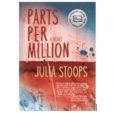To what lengths should we go for a cause—or a person—we’re passionate about and can’t imagine losing? This question lies at the heart of Julia Stoops’ début novel Parts per Million, a suspenseful and harrowing exploration of high-stakes activism, sorely tested friendship, and uncertainly fated love.
Although Parts per Million rotates between the points of view of three characters, one of these characters, John Nelson (known just as Nelson) is the focal point of much of the story. Years before the start of the novel, Nelson left a desk job in the Forest Service—and his marriage—to protest, and occasionally disrupt, threats to the environment.
But eventually, Nelson and two fellow activists—the other point-of-view characters, Jen Owens and Irving Fetzer (known just as Fetzer)—decide to bow out of direct-action environmentalism and devote themselves to reporting on it. From a home they share in Portland, Oregon, the trio runs Omnia Mundi Media Group, which disseminates news on the environmental movement and produces a monthly radio broadcast about it.
Yet current events cause another shift in Omnia Mundi’s mission. It’s the eve of the Iraq War, and at this time of increased government surveillance under the PATRIOT Act, and further threats to civil liberties, Nelson, Jen, and Fetzer decide that they need to broaden their media operation’s reach beyond just environmental concerns. When they learn that local universities are receiving federal money for military projects, including the development of surveillance technology, they seek to uncover more information about these deals and publicize what they find. (More on this later.)
In the meantime, a complication arises in the form of Dierdre O’Carroll, whom a kind-hearted patron of Omnia Mundi brings to the doorstep of Nelson, Jen, and Fetzer. A visitor from Ireland, Deirdre is seriously ill, and she tells the activists that someone stole her money and plane ticket home. (In fact, as only Fetzer learns, she is in withdrawal from a drug addiction.) The original plan is for Deidre to stay in the Omnia Mundi house for just one night, but she ends up entering a relationship with Nelson and becoming part of the household.
To Jen especially, Deidre is a source of tension, mainly because she shares so little about her background, prompting suspicion in the early days of her stay. And even as Deirdre comes out of her shell, revealing warmth, kindness, and a talent for photography, she becomes increasingly troubled, and more reliant on alcohol, for reasons that never become clear to anyone—even Nelson—until the end of the novel. Nelson’s struggle to pull Deirdre out of an apparent downward spiral, and maintain his own sanity in the process, is one of the central conflicts of the novel.
Another major conflict arises from news that Harry Lane University, Nelson’s alma mater, has received a large contract from the Pentagon—surprising, because the university is known as a “bastion of liberalism.” Under the contract, HLU would help develop software allowing military and intelligence agencies to monitor surveillance video and “distinguish suspicious activities from ordinary body movements.” Nelson, Jen, and Fetzer worry that this technology would be used not just in Afghanistan and Iraq but also Stateside.
Through a reporter they know at a local paper, the activists get word of the contract out to the general public. But as they dig deeper, they discover a bigger story: not all the Pentagon funds are going to the project described in the contract. Eventually, they uncover corruption that goes to the top of HLU. Without revealing further details, I’ll just say that Nelson, Jen, and Fetzer’s investigation offers the thrills and suspense of the best detective fiction. Sometimes, the activists are the cat in the investigation; other times, they’re the mouse—with potentially devastating consequences.
But for me, just as compelling as the HLU investigation is the tension it creates between Nelson, Jen, and Fetzer and their differing styles of activism. Nelson is the eloquent, if nerdish, voice of Omnia Mundi, bringing professorial smarts to the HLU investigation and every other endeavor.
Jen is an in-your-face risk-taker, pushing herself and others to do whatever she believes is required for a cause, and going it alone when she feels she has no other choice. Sometimes, this strategy achieves great results, but other times, it endangers both her activism goals and her relationships with Nelson, Fetzer, and Deirdre.
Fetzer, the most seasoned activist of the three, is the voice of reason and experience, often providing essential reality checks.
Usually, the differences between Nelson, Jen, and Fetzer exist in a symbiotic balance, helping the three achieve their collective goals. But conflicts over how to proceed with the HLU investigation threaten to shatter this balance and bring the activists’ relationship, and their mission, to a breaking point. Stoops’ portrayal of this conflict makes for engrossing reading, but it also offers a compelling inside look at collective activism, and all its potential strengths and flaws.
Also, while Parts per Million conveys the real power of collective activism, it doesn’t over-idealize it. For me, one of the most powerful parts of the book is a critique of protest movements offered by Nancy, an African-American employee of HLU and an old friend of Fetzer’s. When Fetzer asks her why there aren’t more people of color at local peace rallies, Nancy says, “Those rallies of yours are all organized by white people, that’s why. They tell their white friends. They advertise in white places. They don’t come into the black communities and let us in on what’s going on, or ask us to get involved.”
Nancy’s sobering critique goes on from there, and every word of it rings true. Although Parts per Million is set fifteen years in the past, her words still feel all too relevant, and they touch on one of the things I most admire about Parts per Million: it offers not just riveting storytelling but also a thoughtful exploration of all that activism can, and should, be.
Would My Pick be Your Pick?
If you're interested in ________, the answer may be "Yes":▪ Suspenseful stories, such as those featured in detective or crime fiction
▪ Stories about activism, especially environmentalism or activism sparked by post-9/11 government action
▪ Explorations of conflicts within personal relationships or within mission-focused collaborations






